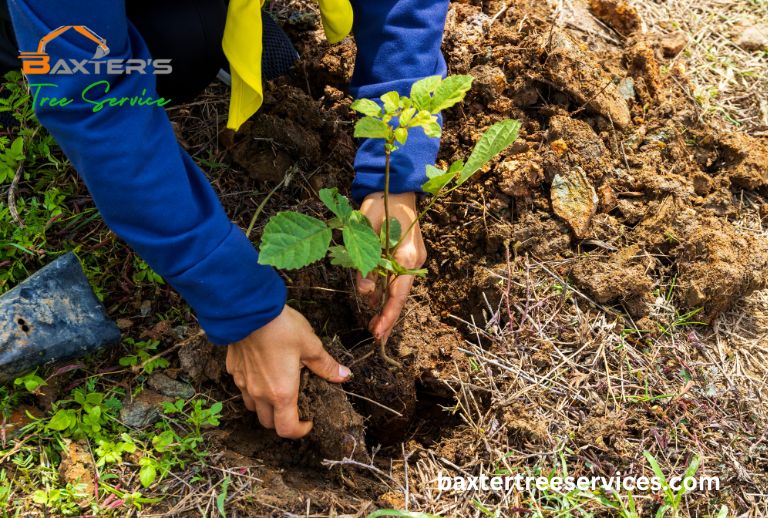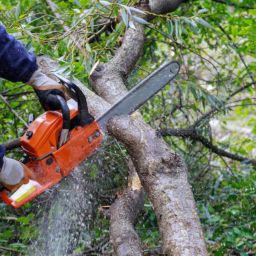
Tree maintenance and replantation are essential factors in safeguarding your house and enhancing its aesthetic. A well-maintained lawn is a haven in the summer season. If you are an avid gardening aficionado, the question of whether you can plan a tree where one was removed may have hit you many times.
The initial answer to this question is a YES. You can replant a new tree from where the old tree was removed. But why are trees even removed?
Trees are removed for several reasons, the most common of which are:
- Invasive root growth
- Diseased tree
- Growth in the wrong place
- Partially dead
Tree Replantation
Tree replantation is essential for saving space and improving the overall look of your property. However, some factors need to be considered while replanting:
- the soil quality
- sunlight exposure
- Any potential disease risks(e.g., pest issue in the old plant)
Soil quality
Different species have different soil requirements. It is important to check the soil quality of the new plant because it will have an impact on tree growth and health.
Sunlight exposure
Sunlight is essential for photosynthesis (the process by which plants make food). Your plant must get the proper sun exposure to grow properly. Check before replanting so that your new tree doesn’t get affected.
Disease risks
While replanting, there is a chance of plant disease that can affect your new tree.
Take precautionary measures such as disease-resistant varieties or treatment of the soil.
So, it is important to check diseases such as pest issues in the old plant, as it helps prevent the spread of diseases to the new tree.
Although replanting on the same spot is not beneficial, it is recommended to grow a new tree at least three feet away from the old spot, and ideally, it is Six to eight feet from the old spot.
For more information regarding planting services, contact Baxtor Tree Services.
Reasons for tree removal and replanting
You might need to cut down a tree for various reasons, requiring careful consideration and planning. However, you might wonder about the environmental impact of removing a tree. While trees are crucial for the environment, cutting down individual trees has minimal impact compared to large-scale deforestation. The following are the reasons why tree removal is beneficial;
Disease or Pest Infestation
When trees are severely diseased or infested with pests, it is essential to prevent the spread of the problem to other trees or plants.
Structural Damage
Trees with significant structural damage, such as large cracks, splits, or leaning, pose a safety risk and may need to be removed to prevent accidents.
Dead or Dying Trees
Dead or dying trees are not only unsightly but also potential hazards. They can fall unexpectedly, causing damage to property or injury to people.
Obstruction
We may need to remove trees for safety or practical reasons if they block views, disrupt utility lines, or encroach on structures.
Root Damage
Trees with extensive root damage, such as those causing pavement upheaval or damaging underground utilities, may need to be removed to prevent further issues.
Reasons for Replanting Trees
Following are the reasons why we should focus on replanting trees;
Environmental Benefits
Trees play a crucial role in mitigating climate change by absorbing carbon dioxide and releasing oxygen. Replanting trees helps maintain biodiversity, provide habitat for wildlife, and improve air quality.
Aesthetic Value
Trees enhance the beauty of landscapes, provide shade, and create a more pleasant environment for residents and visitors.
Soil Stability
Tree roots help prevent erosion, stabilize slopes, and improve soil structure. Replanting trees can help maintain soil stability and prevent landslides or soil degradation.
Shade and Cooling
Trees provide shade, which reduces the temperature in urban areas and helps mitigate the urban heat island effect. Replanting trees contributes to creating more relaxed and more comfortable outdoor spaces.
Economic Benefits
Trees increase property values, attract businesses, and contribute to tourism and recreation. Replanting trees can have positive economic impacts on communities.
Community Health
Trees have been linked to improved mental health, reduced stress, and increased physical activity. Replanting trees in urban areas can enhance the overall well-being of communities.
Challenges in Replanting Trees
Replanting a tree in the same spot can be challenging due to many issues, e.g., diseases affecting the old trees, pest issues, sawdust leftovers, etc.
It is important to prepare a new site while considering all the factors that can damage young trees;
- Don’t use old soil nutrients while replanting
- Beware of any kind of disease and pest issues in old trees
- After removing the old tree, there must be no sawdust(wood particles) left behind.
- Consider spacing while replanting
- Choose appropriate soil nutrients before replanting.
How to Prepare the Site for a New Tree
It is crucial to prepare the site for plantation purposes to avoid unnecessary issues. The first step is to determine the size of the area where a plantation is required. Replant in the same spot where the old one was removed; you should remove the surrounding vegetation and prepare the soil.
The weeds and extraneous grass should be removed with the help of herbicides, plastic sheeting, or multiple tilling. If the previous tree was diseased, there is a chance that the soil and remaining roots have been affected. The issues with the soil should be rectified before the replanting process.
Best Practices for Planting a New Tree
Planting a tree is a rewarding endeavor that contributes to the health of our planet. Whether you’re a beginner or an expert gardener, following these seven steps will help you get it right every time and ensure success in nurturing new life.
Choose the Right Time
You can plant trees at any time of the year, so it is more appropriate to plant trees in the fall and spring seasons when the weather is mild( controlled rainfall). This way, your tree can grow fast without unexpected weather conditions.
Prepare the Hole
When planting, Make the hole three times wider than the root ball but not more profound than its previous environment. Make sure the trunk flare is above the soil level.
Plant Higher
Plant the tree so its base sits slightly higher than the surrounding soil. It will help prevent the tree from sinking over time and reduce the risk of root rot, which can occur if the roots are constantly in soggy soil.
Inspect and Disturb Roots
Check for circular root patterns and break them up to encourage healthy growth. Inspection plays an integral part in planting a new tree.
Don’t Amend Soil
When planting the tree, please don’t put any organic stuff like compost or manure in the hole because it can prevent the roots from spreading out well. Just use the soil that’s already there around the tree.
Eliminate Air Pockets
After you’ve filled the hole halfway with soil, use water to remove any trapped air in the soil. Just pour water into the hole until it’s complete, which will help the soil settle around the tree’s roots.
Add Mulch and Water Properly
Apply mulch, a material that protects plants from weeds, around the tree to retain moisture. Also, water plants should be planted regularly until the tree is fully established. You can also use slow and deep irrigation methods such as drip irrigation or soaker hoses.
Weed: means unwanted plants
While replanting, some of the best tips are as follows;
- When you are ready to replant, check the weather conditions.
- Replanting in spring or fall is more considerate as the weather is mild( controlled rainfall). This will allow your tree to grow fast without unexpected weather conditions.
- The process of replanting is very important. Adequate spacing between trees will help your trees to grow big. After replanting, provide water and food to your trees to retain moisture.
Long-term Care for Your Newly Planted Tree
If you want your trees to grow big, then looking after trees is also essential;
Water your plants
Water regularly, especially during the first year. Allow the soil to dry slightly between waterings to encourage deep root growth.
For this process, you can hire arborists from Baxter Tree Services, who will look after yours as best they can.
Fertilizing
Apply a slow-release fertilizer in spring to provide essential nutrients without overwhelming the young tree. Avoid excessive fertilization, as it can lead to rapid growth but weaken the tree’s structure.
Pruning
Cutting away the extra roots and bushes during the first few years to shape the tree and remove any damaged or crossing branches. Avoid heavy pruning, as it can stress the tree and delay its growth process.
Check and Balance for Pests and Diseases
Regularly inspect the tree for signs of pests, diseases, or any other issues.
Early detection will help you to cure the disease properly without any further damage.
FAQs
Q1) How Soon After Stump Grinding Can You Plant?
Ans) After stump grinding, you can replant immediately as long as you have removed all scrap and the soil is ready to plant.
Q2) Can I Plant Around a Tree Stump?
Ans) Yes, you can plant around a tree stump, but before planting, consider the stump’s size and location to avoid any issues.
Q3) What Do You Put on a Tree Stump to Keep it from Growing Back?
Ans) There are few suitable options to Put on a tree stump to keep it from growing back;
- Grinding a stump will prevent new growth, but this process is a bit prolonged and dangerous and requires serious attention.
- Apply stump killer, which contains herbicide, to avoid any inconvenience.
- Poison/burn the stump
Why Choose Baxter Tree Services For Tree Removal and Expert Advice?
Baxters provide the best tree removal and plantation services as they are available 24/7 for any emergency services.
Other than that, they have been providing planting services for over 20 years at competitive rates;
- Licensed, bonded, and insured
- Free estimates provided
- Good reviews from satisfied customers
- Safety training for our dedicated team
- Commercial-grade equipment for efficient service
You must Consult with Baxtor Tree Services. They have the best arborist or gardening expert.
Yet, they will guide you according to their valuable experience and your situation.




